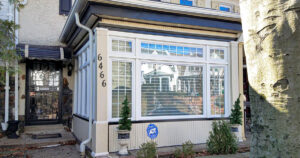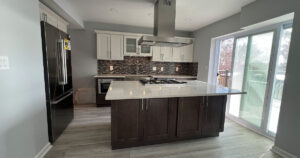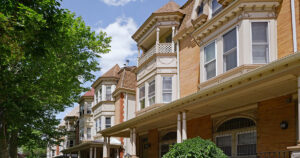Tile can be a difficult decision for a remodel. The needs of the room are often at the front of your mind – heavy moisture, lots of traffic, or exposure to heavy cleaners means that the material needs to be durable.
But there are no shortage of options – for both pattern and material. Taking the time to choose the right updates can make the most out of your remodel.
Choosing Your Tile Material
There are different types of material. Each one comes with unique pros and cons. Here are a few examples to get you started:
- Ceramic: Ceramic is affordable, versatile, and comes in a wide range of colors and styles. It also tends to be the material of choice for those looking to provide a traditional or vintage feel for their bathroom.
- Porcelain: Porcelain is denser and more water-resistant than ceramic, making it ideal for high-moisture areas. It’s a solid choice for upgrading if function is really important to you.
- Natural Stone: Natural stone comes with a lot of options, like granite, quartzite, or travertine. But the options don’t stop there – because the veining for each stone is unique, there are still lots of options for the right appearance even after you know what type of stone you want. It’s important to note that natural stone can be a high maintenance option, though.
- Glass: Glass often feels modern and sleek, creating a light, airy feel. It’s often used as accent pieces, for example, in shower niches.
- Cement: Cement is a modern and industrial option. It’s available in a variety of colors and patterns and is a flexible material that holds up well indoors and outdoors.
Basic Tile Patterns

When it comes to a finished remodel, the pattern is just as important as the material. Here are a few options – starting with some basic arrangements.
- Grid (Stacked): A straightforward pattern where tiles are laid side-by-side in neat rows and columns. This is the ‘safest,’ most neutral pattern in that it can go with a number of decorative approaches.
- Pros: Clean, simple, easy to install.
- Cons: Can look boring in large areas.
- Offset/Staggered Brick (Running Bond): This staggered approach features a pattern that has each tile offset by half of the tile below it.
- Pros: A classic choice that works well with subway tiles.
- Cons: Can be a bit predictable in appearance.
- Diagonal Grid: Tiles are set at a 45-degree angle from the wall.
- Pros: This pattern is similar to herringbone but can use a variety of shaped tiles. It livens up a space and visually expands the area.
- Cons: Also like Herringbone, this tile requires more complex installation and cuts.
Dynamic Tile Patterns

- Herringbone: V-shaped tiles that create a dynamic zigzag pattern.
- Pros: An eye-catching pattern that can add visual interest to a room. It can also make a space look wider, creating the illusion of a large room.
- Cons: Often requires a more complex installation, and may require more cuts.
- Basketweave: An intricate style, with square or rectangular tiles woven together in an alternating pattern.
- Pros: This pattern creates a detailed and textured look that adds elegance and sophistication to a room.
- Cons: It can, however, look busy in small rooms.
- Chevron: Chevron is an old style that is similar to herringbone. It has pointed ends that form a continuous arrow going in one direction and can form a zigzag pattern when the individual pieces are set in opposite directions.
- Pros: This pattern is a little more simple than herringbone and creates a sense of movement within a room. It can be an interesting and neat design choice.
- Cons: Installation of this pattern requires careful planning. Its effectiveness can depend on your overall design.
- Hexagon: These six-sided tiles offer a geometric and modern look.
- Pros: This tile comes in various sizes and can fit well in different design formats.
- Cons: Much like stacked tile, the appearance can be unimpressive over longer floor plans.
- Pinwheel: A rare and ornate style of tile patterning, this kind of tile work requires alternating square and rectangular tiles to create a dynamic spinning effect.
- Pros: Playful, energetic, and ideal for accents.
- Cons: Best used sparingly as its effect can be overwhelming, exhausting, and even irritating over longer floor plans.
Sticking With What Works
Believe it or not, sometimes sticking with what’s there might be the best option. There are many people who like the look of vintage tile. If that’s you, there’s no shame in choosing to remodel your bathroom around what’s already there. Options exist for refreshing your current floor without completely replacing it, or simply updating the tone of the room with new faucets, lighting, or appliances.
Beyond Patterns: Tile Shapes and Sizes
In general, tiles come in a few basic sizes. Several factors can determine what size tile you’ll want to use (like how big the room is, for example).
- Subway Tiles: The classic rectangular tile. Very versatile.
- Large Format Tiles: Minimal grout lines. Creates a seamless look.
- Mosaic Tiles: Small tiles arranged in patterns or images, often used for accents.
Additional Considerations
- Grout Color: You might not think about grout color, but it can complement or contrast the tile, affecting the overall look. There are a lot more options than you might think.
- Texture: Smooth, matte, or textured tiles can add depth to your installation. The Hedron tiles consist of hexagonal tiles that are slightly raised, adding a three dimensional look that catches the idea. These can be great for accents and decorative additions.
- Maintenance: Consider ease of cleaning and durability for your lifestyle.
Consider All Your Options
Tile is an important part of your bathroom, kitchen, or walk space. It needs to be durable, but it should also contribute to your home’s character – and because it’s such a large install, it’s often a central feature to any room. Take your time and figure out what works for you and your needs – there’s no rush when it comes to picking the right style. Let us know when you’re ready to start – we can help.



